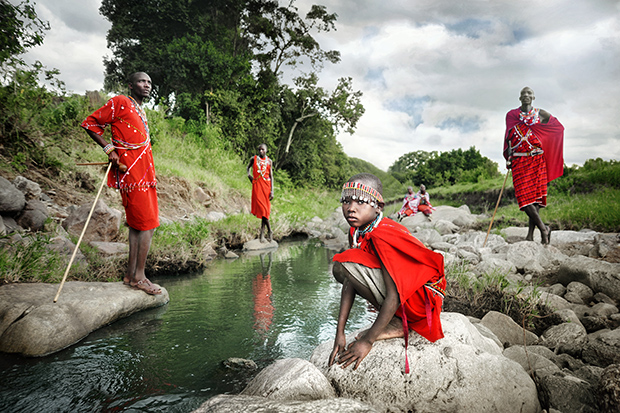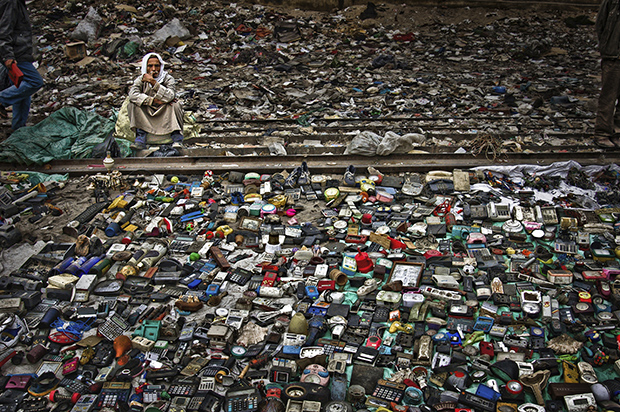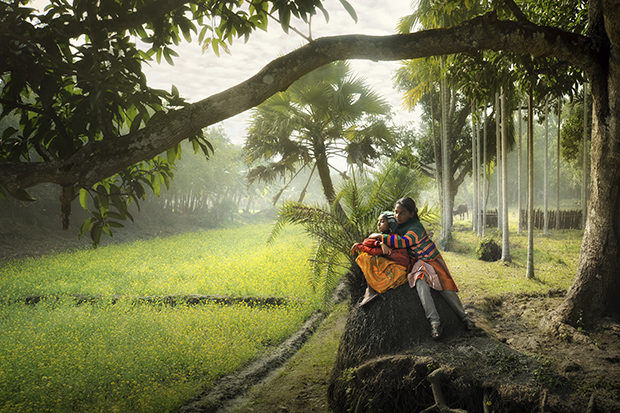Portraiture requires specific skills, but when combined with travel there are a wider range of issues to consider. Veteran travel shooter David Lazar shares 10 useful tips for photographing people during your travels.
Travel photography is the perfect genre for any photographer who likes to shoot in a variety of styles, like landscape, wildlife, architecture and streetscapes. But perhaps the most defining sub-genre of travel photography is portraiture, as it's the people of a country who describe its cultural, ethnic and social construct. Many shooters might agree that photographing people while abroad is the most challenging aspect of travel photography. And how can one capture portraits in a creative and meaningful way, rather than just mere snapshots of a person? As a travel photographer with a passion and focus on cultural photography, here I want to discuss some important techniques and ideas which can be applied while travelling in another country and photographing its people.
01 Interacting with strangers
Initially, it might seem difficult to approach strangers and ask them if you can take their photo. But after some practice you might discover that more people are willing to have their photo taken rather than to decline the request. To increase your chances, the best way is to somehow communicate or interact with people before bringing out the camera. For example, you could comment on their clothes, their surroundings, a game they're playing, or food someone is eating or selling. This can all be done through gestures, though learning some words or phrases in the local language is also a good way to impress.
But it's the facial expressions and actions that are most important when you don't speak the same language. Making eye contact with people, smiling, joking and interacting is the key. After an initial connection, people will usually feel comfortable when you come around to asking if you can take their photo.
The most successful portrait photographs usually feature faces that are full of character, engaging, beautiful, interesting or unique. Try to imagine how you might photograph people you encounter that you'd like to capture, and then try your best to engage with them before asking if you can take their photo. If you're smiling, polite and light hearted in your manner, more often than not people will happily agree.
Then, it's up to you to give a little bit of direction to put together the portrait you envision. It's also important to try to meet people who you don't necessarily plan to photograph, as you never know what the encounter will lead to. You might be invited into someone's home, or get to tour around a place of work or ritual, for example. 
The Masai tribe people live in the wilderness of Kenya and still uphold most of their traditional values and customs. In some circumstances it’s important to take control of your subjects and direct them as to where to go and what to do. Nikon D700, 24-85mm lens @ 24mm, 1/80s @ f/4.5, ISO 500.
02 Approaching with a proposal
It's possible – and it's often done by professional travel photographers – to organise a shoot in advance by paying 'models' for their time, which involves some kind of meeting and prior planning. This has its benefits, as you can gain access to people dressed in traditional clothes that you might not have been able to find or approach otherwise under different circumstances. Examples include tribal groups, cultural performers such as a dancers, and workers of a job which requires them to act out their work at your direction for the sake of a good composition. Because people are getting paid for their time to pose for you, everyone can be happy in this scenario.
An old and cheerful Vietnamese boatman paddles through the waterways of Hoi An, Vietnam. I paid him to paddle me down the river that runs through the town, and all through the trip he was relaxed and continuously smiling – ideal for photographs. Nikon D700, 24-85mm lens @ 40mm, 1/320s @ f/8, ISO 400.
03 Shooting documentary style
Perhaps the most common style of photographing people is to shoot without any interaction with the person in a documentary or reportage style. For some, this might be easier than meeting and engaging with people, but the trade-off is that it's very hard to capture engaging facial expressions which the viewer will respond to.
Reportage style photos can be very powerful, of course, but this style is more difficult to do well because it requires a lot of time out in the field trying to find the right scenes and moments. For me, I prefer meeting with people and constructing a shot idea that's in my mind as this yields higher quality photos in a shorter time, which is a factor for people who are travelling with a limited amount of time in a country.
When you're out and about looking for scenes to document, composition is paramount, and if you can find the potential in
a scene, it's a good idea to wait in one place for as long as it takes until the right person or people come into the frame to complete the composition as you envisioned it. Bodies walking in front of interesting old walls, across a bridge, through an alley or past a temple are all good examples of imagining a shot and patiently waiting for it to play out.
Cario, Egypt. Rubbish which has been salvaged as saleable is taken to a nearby market, where members of the public can browse the selections for whatever use they may find with the items. This man was in charge of the stall. Here I used him as just one element of the total environment. Nikon D70s, 24-85mm lens @ 24mm, 1/200s @ f/7.1, ISO 400.
04 Using the light
Different styles of portrait photos are best shot at specific times of the day. A wide shot of a scene showing a person in their environment should be captured in the 'golden hours' of the day, which is in the early morning or late afternoon. If there is cloud covering the sun you can get lucky with even light at any time of the day, but if you're shooting outdoors and the sun is up high and shining brightly, harsh shadows on a person's face will look unflattering. Hard black lines appear where the shadows form, and the background will have undesirable dark patches as a result of the contrast in the quality of light. Therefore, I try to be active in the earlier and later times of the day, when the sunlight is lower and coming in from the side, creating smoother shadows on the subject.
The alternative might be to use an off-camera flash to fill in for the shadows, but personally I don't travel with flashes.
I favour natural light in my travel photography.
Close-up portraits can still be shot in the middle of day, however, and sometimes to your benefit. By positioning the subject under cover or in the shade, with no direct sunlight hitting surfaces anywhere in the photo which would result in blown-out distractions, you can create nice lighting on the face. For example, at a window or under an awning where there is plenty of light coming from reflections from the ground or in the sky. But there should not be direct sunlight on the skin. This approach also can create very dynamic and engaging catch-lights in the subject's eyes, as you can see the sky, your silhouette, and other objects reflected in the eyes, which makes for 'sparkling' eyes in a photo, and can be further enhanced with software. If you had used a flash, you would only get one circular catch light in the eyes and no interesting patterns. 
Two friends look out over a field of yellow mustard flowers in rural Puthia, Bangladesh. This photo was taken early in the morning on one of my casual wanderings. Early light made a major contribution to creating the wonderful atmosphere in this environmental portrait. Nikon D700, 24-85mm lens @ 34mm, 1/250s @ f/8, ISO 320.
05 Ideas for posing
It's a good idea to have a 'library' of posing concepts in your mind, and to keep thinking and looking around for new ones as you travel, and then commit them to memory. When you have a person who is willing and ready to be photographed, you have to react instantaneously and either shoot them as they are, or give them some direction – which will usually result in a better photo.
This doesn't always have to be a big action or concept; it could just be changing the way they're sitting, or the positioning of their hands. No doubt this is a big test of creativity, and it takes practice and repetition posing people to discover what looks good and what looks contrived 'on film'.
Realism is the key – always ask yourself 'What could the person have naturally been doing?' and keep thinking 'Does this look natural and relaxed or does it look unrealistic'. If it doesn't look natural and relaxed, then you need to change something. People being photographed like direction. They generally trust that you are making them look good and they will happily oblige in anything you ask them to make the photo better.
These are some of the main concepts I like to use:
• Have the subject leaning on a surface or their upper legs while seated. This will make their posture appear relaxed, engaging personal and intimate.
• Have the subject interact with something, for example by touching or holding an object or connecting with another person to convey a story of friendship and care.
• Get the subject involved in an activity, preferably one they would do anyway. Look around for props and objects they might be able to use, such as a soccer ball, a book, an instrument, or a tool (see the image of the young boys with the ball above).
• In a close-up portrait, have an object near the subject's face, to draw attention to the eyes. Examples include fabric around the face, a hand, a wall or a toy. Used in the right way, all these 'props' can add considerably to your efforts in making a relaxed and natural portrait.
• Consider an expression suitable to the moment and direct the subject accordingly. 'Smiling at the camera' type photos are nice, but they depict only one emotion, so at times you might ask the subject not to smile, or to look in a certain direction off camera by pointing at something specific. If the subject doesn't speak English and there's no one who can translate the concept of a serious demeanour, you can demonstrate this yourself by smiling and then changing your face with the swipe of your hand so that the change you want is obvious. In general, doing the pose yourself is the best way to explain it, and your subjects can then copy your action.
In Quthing, Lesotho, a group of children play with their home made soccer ball, and spontaneously jump into the air to compete for it.
I demonstrated to them the action of jumping and kicking to set up this shot. Nikon D700, 24-85mm lens @ 24mm, 1/500s @ f/11, ISO 500.
Check back next week for five more tips to help you shoot stunning travel portraits.
David Lazar is a Brisbane-based travel photographer and musician. His portraits and landscapes from around the globe have been published in National Geographic, Lonely Planet, and in-flight and travel magazines. In 2014 he was awarded Best Culture Photographer by Garuda Airways, Indonesia, and he works with Luminous Journeys by leading photo tours in Myanmar and Bali. See more of his work at: www.davidlazarphoto.com
See Part Two of 'How To Shoot Stunning Travel Portraits







